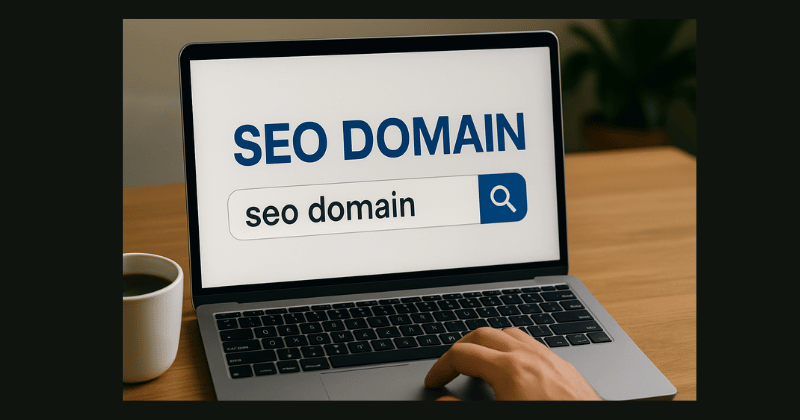For anyone building a brand, launching a niche site, or starting an affiliate business—your domain name can influence how search engines and users perceive your site from day one.
And when chosen well, SEO domain names can quietly boost your rankings, trust, and click-through rates.
But what exactly makes a domain SEO-friendly? And how do you choose the right one?
Let’s break it down thru the following explanations and a video content that we published to provide answer on how to choose SEO domains that will help you rank on the 1st page of Google’s SERP.
Featured Video: Choosing a Domain That Sets You Up for Success
Looking for practical advice on picking the best SEO domain names that won’t just look good—but also perform in search?
Our short video breaks down the essentials every founder, SEO expert, and digital marketer should know when choosing a domain name. You’ll learn:
- Why the right domain can improve brand trust and search visibility
- How to balance keyword relevance with branding
- Mistakes to avoid when naming your site or business
Watch now and set your site up for long-term success—starting with your domain name.

You’ll thank yourself later.
Why Your SEO Domain Names Matter
Search engines like Google have evolved to look at hundreds of signals. But your domain name still plays a subtle, foundational role in how your site is indexed, understood, and even clicked.
Here’s why it matters:
- Relevance: A domain name that reflects your niche or keywords can help both search engines and users immediately understand what your site is about.
- Click-Through Rate (CTR): If your domain includes relevant words or phrases, it can increase the chance of people clicking on your link when they see it in search results.
- Backlink Trust: Domains that are clean, memorable, and keyword-aligned tend to attract more organic backlinks over time.
- Branding + SEO Combo: The best domains do both—build brand recall and reinforce SEO relevance.
What Makes a Domain SEO-Friendly?
There’s no single formula, but there are best practices. Here’s what to keep in mind when choosing a domain name for SEO:
1. Keep It Short, Clean, and Memorable
Avoid hyphens, long strings, or odd spellings. A clean domain is easier to remember, type, and link to. Simplicity wins.
2. Include a Relevant Keyword—Naturally
If you can include a keyword without making it sound spammy or forced, do it. For example, “CoffeeEspresso.com” is clear, niche-aligned, and search-friendly.
3. Go for .com When Possible
While alternative extensions (.io, .co, .ai) are fine in many cases, the .com still carries weight—especially in the eyes of users and backlink sources.
4. Check the Domain History
Before you buy, use tools like Wayback Machine and backlink checkers to ensure the domain hasn’t been used for spam or shady content in the past.
The Power of Aged and Expired Domains for SEO
One of the smartest ways to fast-track your SEO momentum is by acquiring aged or expired domain names—especially those with a clean backlink history and past relevance in your niche.
Here’s why experienced SEOs and affiliate marketers value them:
1. Built-In Authority
Aged domains that were once used for legitimate businesses or content sites may already have links from news outlets, blogs, and resource pages. This means your new project doesn’t start from scratch—it starts with inherited trust.
2. Faster Indexing & Ranking Potential
Google is often quicker to index and test content from aged domains. Especially if the backlinks are still live, your new pages could rank much faster than if launched on a fresh domain.
3. A Clean Reputation Matters
Not all expired domains are equal. That’s why we carefully vet each one for spam-free backlink profiles, no shady redirects, and a clear archive history.
4. Ideal for Niche Sites, Redirect Strategies & Authority Builds
Whether you’re launching a niche blog, a lead gen site, or looking to 301 redirect an aged domain to boost your main brand’s SEO—these domains are valuable digital assets.
Explore our curated list of SEO domains at C9Domains
Every domain is hand-checked for backlinks, relevance, and authenticity—so you can invest with confidence.
Building a Private Blog Network (PBN) for SEO?
If you’re exploring advanced SEO strategies, including the use of Private Blog Networks (PBNs) to build authority and pass link equity—choosing the right domains is critical.
The strongest PBNs are built on clean, aged domains with legitimate backlink profiles and no history of spam or penalization. These domains:
- Hold real SEO value and trust
- Help boost your target site without raising red flags
- Should be niche-aligned and manually reviewed
Browse PBN Domains at C9Domains
Our listings focus on domains that meet strict quality standards for PBN use, helping you avoid penalties and maximize your link-building efforts.
Checking SEO Domain Names Availability
Once you’ve brainstormed a potential domain name, the first step is obvious: check if it’s available. Most registrars will tell you right away if your exact match is taken—or suggest close alternatives.
But availability is just the surface.
To make a smart decision, especially if SEO is your goal, you’ll want to dig deeper and assess the domain’s digital footprint before buying. Here’s what to check:
1. Search Engine Results (SERPs)
Type the name into Google and observe what comes up. Are there existing brands using similar names? Are there news stories, shady listings, or unrelated businesses tied to the phrase?
If the domain has existing associations—good or bad—you’ll want to know before committing.
2. Trademark Conflicts
Don’t skip this. Just because a domain is available doesn’t mean it’s legally safe to use.
A quick trademark search through USPTO.gov or a global database can reveal whether your chosen name is protected. Using a trademarked name—intentionally or not—can get you into legal trouble down the road.
3. Backlink History and Past Use
Use tools like Ahrefs, Moz, or free backlink checkers to inspect whether the domain has existing backlinks, especially from reputable sites.
Also, check the Wayback Machine to view archived versions of the site. Was it used for a blog, e-commerce store, spam network, or parked for years?
This history can either work in your favor (SEO boost) or against you (penalties, bad reputation).
A Word of Caution—and Opportunity
A domain that’s technically “available” might still carry digital baggage. It could have been:
- Previously penalized by Google
- Involved in a PBN or link scheme
- Associated with adult content or spam
But sometimes, it also comes with hidden upside—like aged backlinks, mentions in articles, or brand mentions that are still indexed.
If you do your homework, you might stumble upon a diamond in the rough.
For a shortcut, check our curated list of recently expired domains. We highlight domains that are SEO-friendly, clean, and full of potential.
Looking for domain names that just dropped? Check out our latest guide on recently expired domains to discover how to find high-potential names with SEO value—updated daily and ready for your next project.
Choose a Domain Name for SEO Strategically
SEO domain names aren’t about stuffing keywords or gaming the system. They’re about strategic alignment between what you want to rank for and how you present yourself online.
Whether you’re building from scratch or buying a domain with a head start, the right name can shave months off your SEO journey.
And in a world where authority and trust are everything, that edge matters.
Ready to Find Your SEO Advantage?
Browse curated aged, branded, and keyword-friendly SEO domain names for sale at C9Domains. Each one is reviewed for backlink history, niche alignment, and clean reputation—so you can start strong.












